The Evolution of Tokenization Viability Scoring (TVS): Continuous Improvement in Asset Evaluation
As artificial intelligence (AI) continues to reshape the digital landscape, businesses must prioritize the optimization of their websites for AI agents. These intelligent systems, such as chatbots, virtual assistants, and recommendation engines, are becoming crucial in enhancing user engagement and streamlining customer service. By ensuring your website is compatible with AI technology, you can provide a more personalized experience, improve customer satisfaction, and drive conversions.

Optimizing your website for AI agents involves several strategic approaches, from implementing structured data to enhancing site speed and mobile responsiveness. Utilizing tools like schema markup can help AI agents better understand your content, enabling them to deliver more relevant information to users. Moreover, ensuring that your website is user-friendly and accessible will not only aid AI agents in navigating your site but also improve overall user experience. In this blog, we will delve into effective strategies for optimizing your website for AI agents, highlighting the importance of AI compatibility in today’s competitive digital market.\
TABLE OF CONTENTSWhat Are AI Agents?Types of AI Agents
The Role of AI Agents in Modern Web
Key Strategies for Optimizing Your Website for AI Agents
· 1. Structured Data Implementation for Optimizing AI Agents
· 2. Clear Content Hierarchy for Optimizing AI Agents
· 3. Natural Language Optimization for AI Agents
· 4. Technical Optimization for AI Agents
· 5. Metadata Optimization for AI Agents
· 6. Content Quality and Relevance for AI Agents
· 7. AI-Friendly Navigation for Optimal User Experience
· 8. Semantic Search Optimization for Enhanced AI Understanding
· 9. Performance Monitoring for AI Agents
· 10. Security and Privacy for AI Optimization
· 11. Multimedia Optimization for AI Agents
· 12. API Integration for Enhanced AI Interaction
· 13. User Experience Considerations for AI Optimization
Conclusion
FAQsWhat Are AI Agents?
AI agents are autonomous software entities that utilize artificial intelligence to perform tasks, make decisions, or interact with users or other systems in a manner that simulates human-like behavior. These agents can range from simple chatbots that respond to user queries to complex systems capable of learning and adapting their actions based on data inputs and environmental changes.
Types of AI Agents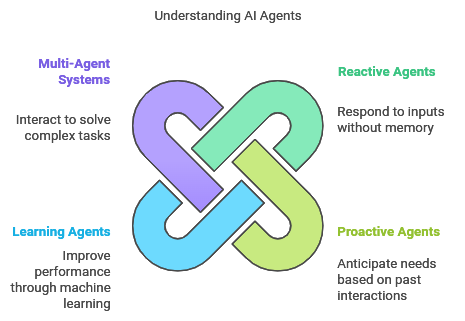
- Reactive Agents: These agents respond to specific inputs without maintaining a memory of past interactions. They operate based on predefined rules and are often used in simple applications like rule-based chatbots.
- Proactive Agents: Unlike reactive agents, proactive agents can anticipate user needs or actions based on previous interactions or learned experiences. They can initiate actions to achieve specific goals, such as recommending products based on a user’s browsing history.
- Learning Agents: These agents utilize machine learning techniques to improve their performance over time. They learn from past experiences, adapt their strategies, and optimize their actions based on feedback from the environment.
- Multi-Agent Systems: These involve multiple AI agents that interact with each other to accomplish complex tasks. Each agent can have its own objectives, and they can collaborate or compete to achieve their goals, often used in simulations or for complex problem-solving.
AI agents play a transformative role in modern web environments by enhancing user experiences, automating processes, and providing personalized interactions. These intelligent agents, such as chatbots and virtual assistants, streamline customer service by offering instant responses to inquiries, guiding users through complex tasks, and even resolving issues autonomously. By leveraging machine learning algorithms, AI agents can analyze user behavior and preferences, enabling them to deliver tailored content, recommendations, and advertisements that resonate with individual users.
Moreover, in the realm of data management, AI agents facilitate efficient information retrieval, automate content generation, and optimize search engine results, thus improving the overall functionality and accessibility of web platforms. Their ability to operate continuously and learn from interactions not only increases operational efficiency but also fosters deeper engagement, making them indispensable in the evolving landscape of the internet.
Key Strategies for Optimizing Your Website for AI Agents1. Structured Data Implementation for Optimizing AI Agents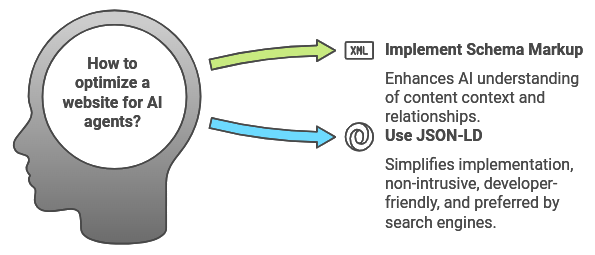 Schema Markup
Schema MarkupImplementing proper schema markup is one of the most effective strategies to optimize your website for AI agents. Schema markup helps AI systems understand the context and relationships within your content, enabling better interpretation and enhanced search results. Focusing on key areas of schema markup can significantly improve visibility and interaction with AI agents:
- Product Schema: Essential for e-commerce sites, this schema provides detailed information about products, such as pricing, availability, and reviews, enhancing search results and user engagement.
- Article Schema: For blog posts and articles, this markup helps define the content type, allowing AI agents to better categorize and display your articles in relevant search results.
- Organization Schema: This schema markup conveys crucial business information, including name, logo, and contact details, which aids AI agents in accurately presenting your organization’s identity in search results.
- FAQ Schema: Implementing FAQ schema allows you to mark up frequently asked questions, making it easier for AI agents to provide direct answers in search results, enhancing user experience.
- Event Schema: For businesses hosting events, this markup provides details about upcoming activities, helping AI agents display relevant event information in search results and improving attendance.
Among various formats for structured data, JSON-LD is the preferred choice for implementing schema markup for several reasons:
- Ease of Implementation: JSON-LD is simpler to add to your web pages without disrupting existing HTML content, allowing for a more straightforward integration process.
- Non-intrusive: Since JSON-LD does not interfere with the existing HTML markup, it preserves the integrity of your website’s structure while enhancing its capabilities for AI agents.
- Developer-Friendly: JSON-LD is more readable and understandable for developers, facilitating easier maintenance and updates.
- Search Engine Preference: Major search engines and AI systems favor JSON-LD, which can lead to better indexing and representation in search results.
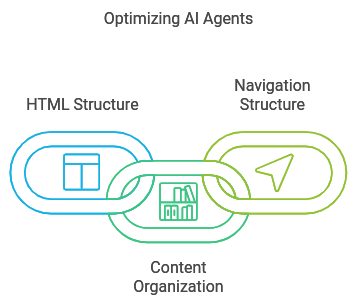 HTML Structure
HTML StructureEstablishing a proper HTML structure is crucial for aiding AI agents in understanding the relationships between different content elements on your website. By adhering to best practices in HTML, you can enhance content discoverability and improve user experience:
- Appropriate Heading Tags (H1-H6): Utilize heading tags hierarchically to establish a clear content hierarchy. The H1 tag should represent the main title, while subsequent tags (H2, H3, etc.) should denote subheadings, allowing AI agents to grasp the organization of your content quickly.
- Semantic HTML5 Elements: Implement semantic HTML5 elements such as
, , , - Logical Content Flow: Maintain a logical flow of information throughout your content. Present ideas in a coherent sequence, which helps both users and AI agents follow along easily, ensuring that key points are not lost.
- Descriptive HTML Elements: Use descriptive attributes for elements, such as alt tags for images and title attributes for links. This not only enhances accessibility but also provides AI agents with more context about the content.
Organizing content in a clear and logical manner is essential for maximizing its effectiveness and facilitating easy navigation:
- Group Related Information: Cluster related information together to create a cohesive narrative. This helps users and AI agents understand the context and relevance of each section, making it easier to find and comprehend the content.
- Clear Section Breaks: Use clear section breaks to differentiate between different topics or ideas. This can be achieved through headings, spacing, or visual elements, making it visually appealing and easy to digest.
- Proper Navigation Structure: Implement a well-structured navigation system that allows users and AI agents to move through your website effortlessly. Clear menus and breadcrumbs enhance usability and enable AI systems to index your content more effectively.
- Table of Contents for Longer Content: For longer articles or guides, consider including a table of contents at the beginning. This not only improves user experience by allowing readers to jump to specific sections but also provides AI agents with a structured overview of your content, aiding in indexing and relevance assessment.
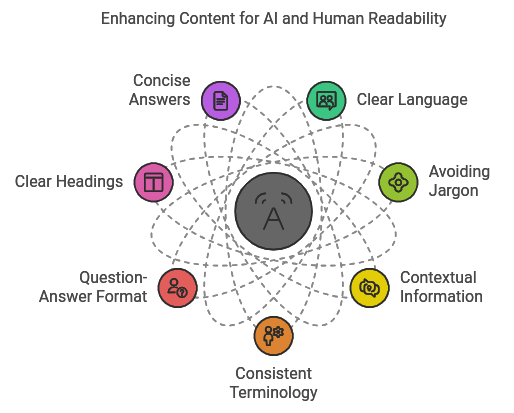 Conversational Content
Conversational ContentOptimizing your content for natural language is essential for ensuring that it is easily understood by both human readers and AI agents. This involves adopting a conversational tone that enhances clarity and engagement:
- Clear, Natural Language: Aim to write in a way that feels natural and conversational. Use straightforward language that is accessible to a broad audience, avoiding overly complex sentences that may confuse readers or AI systems. A friendly, approachable tone can make your content more relatable.
- Avoid Unnecessary Jargon: While some technical terms may be necessary in specific contexts, it’s important to limit the use of jargon that may alienate readers. When technical language is unavoidable, consider providing brief explanations or definitions to ensure comprehension.
- Include Contextual Information: Providing context enhances understanding, especially when discussing complex topics. Use examples, analogies, or real-life scenarios to illustrate your points, helping both readers and AI agents grasp the meaning and relevance of your content more effectively.
- Maintain Consistent Terminology: Consistency in terminology is crucial for clarity. Using the same terms throughout your content helps to avoid confusion and reinforces understanding. If you introduce a new term or concept, ensure that you consistently refer to it the same way to create a cohesive narrative.
Employing a question-and-answer format can significantly enhance the readability and effectiveness of your content. This approach not only engages users but also aligns well with how AI agents retrieve information:
- Directly Address User Queries: Anticipate common questions or concerns that your audience may have and address them directly in your content. Structuring your content around these questions makes it more likely to satisfy user intent and improve its chances of being featured in voice searches or AI-driven responses.
- Utilize Clear Headings: Use clear headings or bullet points for each question to break up the content visually. This helps users navigate quickly and allows AI agents to index the information efficiently.
- Provide Concise Answers: Keep answers concise yet informative, ensuring that they deliver the necessary information without overwhelming the reader. Use lists or step-by-step instructions when appropriate, as these formats are easily digestible and can enhance user experience.
 Loading Speed
Loading SpeedOptimizing your website’s loading speed is crucial for enhancing performance and ensuring efficient AI crawling. A fast-loading site improves user experience and enables AI agents to index content more effectively. Here are some key strategies:
- Minimize HTTP Requests: Reduce the number of individual requests made to the server by combining CSS and JavaScript files where possible. Each request can slow down load times, so fewer requests mean faster performance.
- Optimize Images and Media: Compress images and use modern formats (such as WebP) to decrease file sizes without sacrificing quality. Additionally, implement lazy loading techniques to only load images when they enter the viewport, which can significantly enhance load speed for users.
- Implement Caching: Utilize browser caching to store static resources on users’ devices. This means that repeat visitors will load your site faster since their browsers won’t need to request all assets again. Server-side caching can also improve performance by reducing the load on the server.
- Use Content Delivery Networks (CDN): CDNs distribute your website’s content across multiple servers worldwide. This ensures that users receive data from the nearest server, significantly reducing load times and improving performance.
- Compress Files and Code: Minify CSS, JavaScript, and HTML files to eliminate unnecessary characters, comments, and whitespace. This reduces file sizes, making them quicker to download. Gzip compression can further reduce the size of files sent to users’ browsers.
In today’s mobile-first world, ensuring that your website is responsive and functions well across all devices is critical. This not only enhances user experience but also aids in SEO rankings, as search engines prioritize mobile-friendly sites. Here are important considerations for mobile responsiveness:
- Implement Responsive Design: Use fluid grids, flexible images, and CSS media queries to create a layout that adjusts seamlessly to different screen sizes. This approach ensures that your content is visually appealing and usable on devices from smartphones to tablets and desktops.
- Test Across Different Screen Sizes: Regularly test your website on various devices and screen sizes to ensure a consistent experience. Tools like Google’s Mobile-Friendly Test can help identify any issues that may affect mobile users.
- Optimize Touch Interactions: Ensure that buttons and interactive elements are easily tappable on touch devices. Use appropriate sizes and spacing to avoid mis-taps, making navigation intuitive for mobile users.
- Ensure Consistent Content Access: Verify that all users can access the same content regardless of their device. Avoid content blocks or functionalities that only work on desktop versions, ensuring that mobile users have a complete experience.
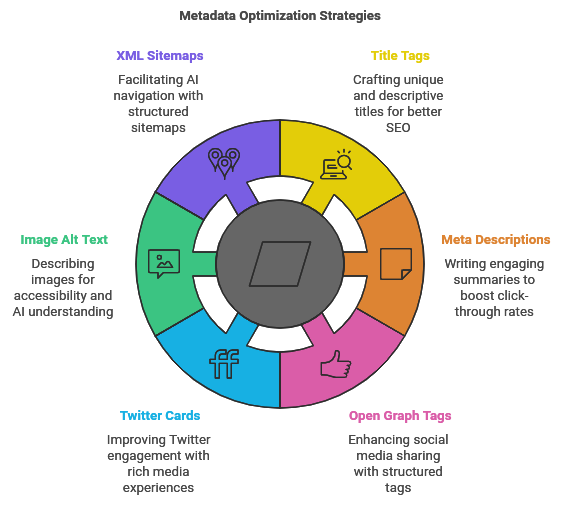 Meta Tags
Meta TagsImplementing comprehensive metadata is essential for guiding AI agents in understanding your content and its context. Properly structured meta tags enhance how your pages are indexed and displayed in search results, ultimately improving visibility and click-through rates. Here are the key components to focus on:
- Title Tags: Craft unique and descriptive title tags for each page. These should accurately represent the content while including relevant keywords to improve search engine rankings. Keep titles concise (typically under 60 characters) to ensure they display correctly in search results.
- Meta Descriptions: Write compelling meta descriptions that summarize the content of each page. Although not a direct ranking factor, an engaging description can influence click-through rates. Aim for around 150–160 characters and incorporate relevant keywords and a clear call to action.
- Open Graph Tags: These tags are crucial for social media sharing, ensuring that your content is presented attractively on platforms like Facebook and LinkedIn. Include tags that specify the title, description, image, and URL to control how your content appears when shared.
- Twitter Cards: Similar to Open Graph tags, Twitter Cards allow you to enhance how your content is displayed on Twitter. Implementing the appropriate tags can lead to richer media experiences, increasing engagement when users share your content.
- Image Alt Text: Provide descriptive alt text for all images on your site. This not only improves accessibility for users with visual impairments but also helps AI agents understand the content of your images. Alt text should be descriptive and relevant to the image context, ideally including keywords where appropriate.
Creating detailed XML sitemaps is essential for facilitating navigation for AI agents and ensuring that all important pages of your site are indexed effectively. A well-structured sitemap provides a roadmap for search engines, enabling them to crawl and index your content more efficiently. Key aspects include:
- Include All Important Pages: Ensure that your sitemap lists all significant pages on your website, including product pages, blog posts, and landing pages. This helps AI agents discover and access your content quickly.
- Update Regularly: Regularly update your sitemap to reflect any changes to your site, such as new content, updated pages, or removed links. Keeping your sitemap current ensures that AI agents have the latest information about your site’s structure.
- Implement Proper Hierarchy: Structure your sitemap in a logical hierarchy that mirrors your site’s organization. This not only aids in user navigation but also helps AI agents understand the relationship between various pages.
- Include Last Modified Dates: Including last modified dates for each page in your sitemap informs search engines about the freshness of your content. This can encourage more frequent crawls and help ensure that your most up-to-date information is indexed.
High-quality content is paramount for engaging both users and AI agents effectively. It serves as the foundation of your website and plays a significant role in determining how well your pages rank in search results. Here are essential aspects to consider for maintaining content quality:
- Originality and Uniqueness: Ensure that all content is original and provides unique insights or perspectives. Plagiarized or duplicated content can lead to penalties from search engines and diminish user trust. Focus on creating informative articles, guides, and resources that add value to your audience.
- Depth and Comprehensiveness: Strive for depth in your content by covering topics comprehensively. Detailed articles that answer common questions, provide in-depth analysis, or explore various aspects of a subject tend to perform better in search rankings. Aim for long-form content where applicable, as it often resonates more with users and AI systems alike.
- Use of Reliable Sources: Support your claims with credible sources and references. Including citations and linking to authoritative sites enhances your content’s credibility and allows AI agents to understand the reliability of your information. This is especially important for topics that require expert knowledge or statistical data.
Content relevance ensures that what you publish aligns with user intent and meets the needs of your audience. AI agents prioritize content that is directly applicable to search queries, making relevance a critical factor in your optimization strategy. Consider the following aspects:
- Keyword Research: Conduct thorough keyword research to identify the terms and phrases your target audience is using. This helps you create content that addresses specific queries and aligns with user intent. Use a mix of short-tail and long-tail keywords to capture a wider range of searches.
- User Intent Alignment: Understand the different types of user intent — informational, navigational, transactional, etc. — and tailor your content accordingly. Ensure that each piece of content fulfills the intent behind the search queries you’re targeting. For example, blog posts should aim to inform, while product pages should facilitate purchasing decisions.
- Engagement Metrics: Monitor user engagement metrics, such as bounce rate, time on page, and click-through rates, to assess content effectiveness. High engagement typically indicates that your content is resonating with users, while low metrics may suggest a need for improvement in relevance or quality.
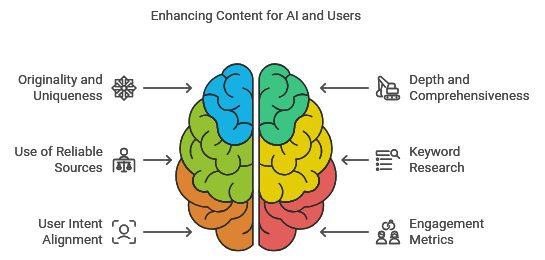 Clear Site Structure
Clear Site StructureA well-structured website is essential for both user experience and effective AI agent navigation. By implementing a logical and intuitive site structure, you facilitate easier access to content while ensuring that AI agents can crawl your site efficiently. Key components of a clear site structure include:
- Intuitive Navigation Menus: Design navigation menus that are simple and straightforward. Use clear labels that accurately describe the content found within each section. A well-organized menu helps users quickly locate what they are looking for and guides AI agents through the hierarchy of your content.
- Breadcrumb Trails: Implement breadcrumb navigation to provide users and AI agents with a clear path of how they arrived at their current location on the site. Breadcrumbs enhance usability by allowing users to easily backtrack to previous sections, while also helping AI agents understand the structure and relationships between different pages.
- Related Content Links: Encourage deeper engagement by including links to related content. This not only helps users discover additional relevant information but also provides context for AI agents, making it easier for them to understand the connections between different topics.
- Clear Categories and Tags: Organize your content into well-defined categories and utilize tags to group related topics. This structure aids in filtering content for users while providing AI agents with essential metadata about the content’s context and relationships.
Creating a strong internal linking structure is vital for enhancing navigation and optimizing AI crawling. Internal links guide users to relevant pages and help AI agents discover content that may not be easily accessible. Key strategies for effective internal linking include:
- Relevant Anchor Text: Use descriptive and relevant anchor text for internal links. This helps both users and AI agents understand what to expect when clicking on a link. Avoid generic phrases like “click here”; instead, provide context that reflects the destination content.
- Logical Link Placement: Position internal links strategically within your content to enhance flow and relevance. For instance, linking to related articles within the body of your text or placing them in sidebar widgets can increase visibility and encourage user exploration.
- Regular Link Audits: Conduct regular audits of your internal linking structure to identify broken links, outdated references, or missed opportunities for linking. Ensuring that all internal links are functional and relevant improves the overall user experience and helps maintain the integrity of your site’s navigation.
- Proper Link Hierarchy: Maintain a clear hierarchy in your internal linking strategy. Important pages should be easily accessible, with fewer clicks needed to reach them. Use a tiered approach, where primary content is linked prominently and secondary content is accessible through related links.
 Entity Recognition
Entity RecognitionSemantic search optimization focuses on helping AI agents understand the entities within your content, which in turn improves how search engines interpret and rank your pages. By implementing effective strategies for entity recognition, you can enhance the relevance and visibility of your content. Here are key components to consider:
- Define Key Concepts Clearly: Clearly define the key concepts and entities within your content. This includes providing precise definitions and contextual information that helps AI agents grasp the importance and relevance of these entities within your overall narrative.
- Use Consistent Terminology: Consistency in terminology is vital for AI understanding. Use the same terms throughout your content to refer to specific concepts or entities, reducing ambiguity and enhancing clarity for both users and AI agents.
- Link to Authoritative Sources: Linking to authoritative sources reinforces the credibility of your content and provides additional context for AI agents. When relevant, include citations and references to reputable articles, research papers, or industry standards to support your definitions and claims.
- Implement Entity Markup: Utilizing structured data formats like Schema.org to implement entity markup can significantly enhance AI comprehension. By explicitly marking up entities, such as people, places, organizations, and events, you enable search engines to better understand the relationships and context within your content.
Organizing your content around main topics helps both users and AI agents navigate and comprehend the subject matter more effectively. Topic clustering creates a framework that enhances the relevance of your content and its discoverability in search results. Key strategies for effective topic clustering include:
- Create Topic Clusters: Develop clusters of related content that revolve around a central theme or topic. This can include a pillar page that covers the main topic in-depth, along with several supporting articles that explore specific subtopics. This structure not only enhances user experience but also signals to AI agents that your content is comprehensive and well-organized.
- Link Related Content: Interlink the content within your topic clusters to strengthen the connection between related articles. This practice not only aids in user navigation but also helps AI agents recognize the thematic relationships among your content pieces, improving overall contextual understanding.
- Maintain Content Hierarchy: Ensure that your topic clusters maintain a clear content hierarchy. The pillar page should serve as the primary resource on the topic, while supporting articles delve into specific aspects. This hierarchical structure aids both users and AI agents in navigating your content and understanding its organization.
- Use Consistent Terminology: Just as with entity recognition, using consistent terminology across your topic clusters is essential. This consistency reinforces the relationships between content pieces and helps both users and AI agents understand the overarching themes.
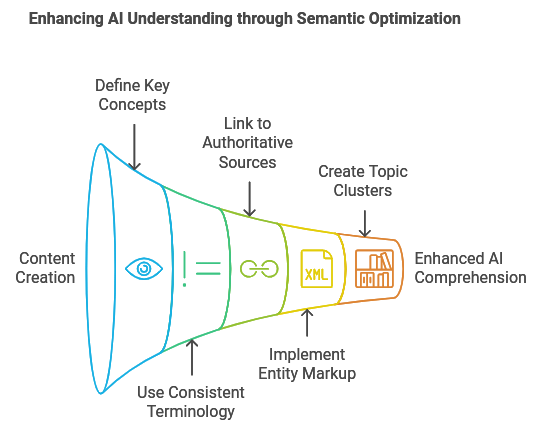 Analytics Implementation
Analytics ImplementationTo optimize your website for AI agents effectively, implementing a comprehensive analytics strategy is crucial. This allows you to track how these agents interact with your site, providing valuable insights into performance and user engagement. Key aspects of analytics implementation include:
- Implement Comprehensive Analytics: Utilize advanced analytics tools such as Google Analytics, Matomo, or Adobe Analytics to gather detailed data about site traffic, user behavior, and engagement metrics. Ensure that these tools are set up to track not just human visitors but also AI agent interactions, providing a complete view of your audience.
- Monitor Bot Traffic: Regularly analyze bot traffic to understand how AI agents are crawling and indexing your site. By distinguishing between human and bot visits, you can identify which pages are attracting the most attention from AI systems, enabling you to optimize those pages further.
- Track User Interactions: Use event tracking and user interaction metrics to assess how visitors engage with your content. Metrics such as click-through rates, time on page, and user journey paths provide insights into what content resonates best, informing future optimization efforts.
Identifying and addressing technical issues is essential for maintaining a well-functioning website that is accessible to both users and AI agents. Effective error monitoring helps ensure that your site remains operational and user-friendly. Key components of error monitoring include:
- Regular Crawl Error Checks: Utilize tools like Google Search Console or Screaming Frog to conduct regular crawl error checks. These tools identify any issues that AI agents may encounter while indexing your site, such as broken links, inaccessible pages, or server errors.
- 404 Error Monitoring: Keep a close eye on 404 errors, which indicate that a page could not be found. Implement redirects for outdated or moved content to improve user experience and ensure that AI agents do not encounter dead ends when crawling your site.
- Server Response Monitoring: Regularly monitor server responses to ensure that your website is consistently available and performing optimally. Use uptime monitoring tools to track server performance and address any downtime or slow response issues promptly.
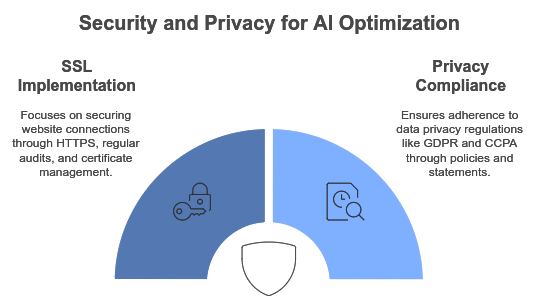 SSL Implementation
SSL ImplementationSecuring your website is paramount, especially in an era where data breaches and privacy concerns are prevalent. Implementing SSL (Secure Socket Layer) is one of the first steps to ensure that connections to your site are secure and trustworthy. Key considerations for SSL implementation include:
- HTTPS Implementation: Transition your site from HTTP to HTTPS by obtaining an SSL certificate. This encryption protocol not only protects data transmitted between users and your site but also builds trust with visitors and AI agents, as search engines often prioritize secure sites in rankings.
- Regular Security Audits: Conduct regular security audits to identify vulnerabilities and ensure that your SSL configuration is up to date. These audits should encompass both server security and application-level security, assessing any potential weaknesses that could be exploited by malicious actors.
- Proper Certificate Management: Ensure that your SSL certificates are properly managed and renewed before expiration. This includes tracking certificate expiration dates and understanding the specific requirements of your hosting environment to avoid unexpected downtime or security warnings.
- Security Headers: Implement HTTP security headers to add an extra layer of protection against common vulnerabilities such as cross-site scripting (XSS) and clickjacking. Headers like Content Security Policy (CSP), X-Content-Type-Options, and X-Frame-Options help fortify your site against various attacks.
As regulations surrounding data privacy evolve, maintaining compliance with privacy standards is critical for protecting user data and fostering trust. Adopting a comprehensive approach to privacy compliance involves:
- GDPR Compliance: If your website caters to users in the European Union, it is essential to comply with the General Data Protection Regulation (GDPR). This includes obtaining explicit consent for data collection, providing users with rights to access and delete their data, and ensuring transparency about how their information will be used.
- Cookie Policies: Implement clear cookie policies that inform users about the types of cookies used on your site and their purposes. Providing options for users to manage cookie preferences enhances transparency and complies with various privacy regulations, including the GDPR and the California Consumer Privacy Act (CCPA).
- Privacy Statements: Draft comprehensive privacy statements that outline your data collection practices, how you use personal information, and the measures you take to protect user data. This document should be easily accessible to users and updated regularly to reflect any changes in policy or practice.
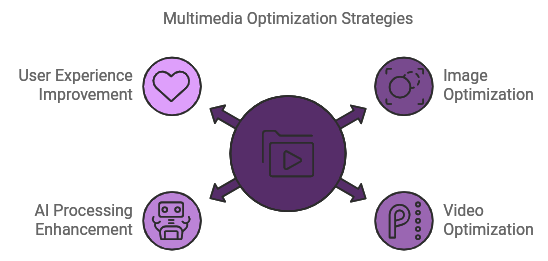 Image Optimization
Image OptimizationOptimizing images is crucial for enhancing user experience and ensuring that AI agents can efficiently process visual content. Here are the key practices for effective image optimization:
- Descriptive File Names: Use descriptive and keyword-rich file names for your images. This practice not only helps AI agents understand the content of the images but also improves search visibility in image search results. For example, instead of naming an image “IMG123.jpg,” use a name like “blue-running-shoes.jpg” to provide context.
- Relevant Alt Text: Implement relevant alt text for each image, describing its content and function. Alt text is essential for accessibility, allowing visually impaired users to understand what the image depicts. Moreover, it provides AI agents with additional context about the image, enhancing the overall understanding of your webpage’s content.
- Proper Image Compression: Compress images to reduce file size without sacrificing quality. This optimization ensures faster loading times, which is critical for user experience and search engine ranking. Tools like TinyPNG or ImageOptim can help compress images effectively.
- Responsive Images: Use responsive image techniques (such as the srcset attribute) to ensure that images display correctly on various devices and screen sizes. This approach not only enhances the user experience but also aids AI agents in understanding how images relate to different content contexts.
Videos are increasingly important for engagement, and optimizing video content is essential for AI processing and search visibility. Here are the best practices for video optimization:
- Video Transcripts: Provide transcripts for all video content. Transcripts make your videos accessible to a broader audience, including those with hearing impairments. They also allow AI agents to crawl and index the video content, improving search visibility.
- Closed Captions: Include closed captions in your videos to enhance accessibility and comprehension. Captions benefit users who may be watching in noisy environments or those who prefer reading along while watching, and they provide additional context for AI agents to analyze.
- Meta Descriptions: Write compelling meta descriptions for your videos that summarize their content. These descriptions not only aid in search engine optimization but also entice users to click and engage with the video.
- Structured Data Markup: Implement structured data markup for video content using schema.org’s VideoObject type. This markup helps search engines understand the video’s content and can enhance visibility in search results, often resulting in rich snippets that include video thumbnails and play buttons.
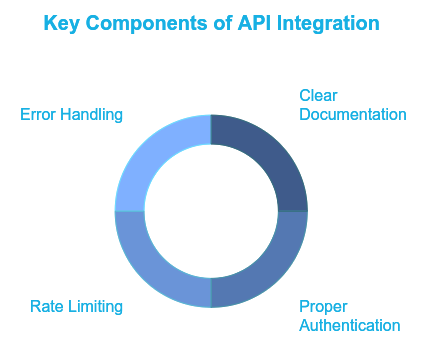
Integrating RESTful APIs is crucial for enabling smooth interaction between your website and AI agents. These APIs allow external systems to access and manipulate your data efficiently. Here are key considerations for implementing RESTful APIs:
- Clear Documentation: Provide comprehensive and user-friendly documentation for your APIs. This should include detailed instructions on how to use the API, including endpoint descriptions, request and response formats, and examples. Well-documented APIs facilitate easier integration for developers and improve the overall user experience.
- Proper Authentication: Implement robust authentication mechanisms to secure your APIs. Utilize methods such as OAuth 2.0 or API keys to ensure that only authorized users and systems can access your data. This is vital for protecting sensitive information and maintaining the integrity of your service.
- Rate Limiting: Establish rate limiting to manage the number of requests a user or system can make in a given time frame. This practice prevents abuse and ensures fair usage of resources, which is particularly important in scenarios where multiple users or AI agents may be accessing your APIs simultaneously.
- Error Handling: Implement comprehensive error handling to provide meaningful error messages and status codes. Clear error responses help developers diagnose issues more effectively, improving the overall reliability and usability of your API.
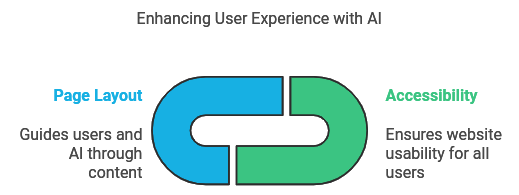 Accessibility
AccessibilityEnsuring that your website is accessible to all users is a fundamental aspect of creating a positive user experience, and it also enhances how AI agents interact with your content. Here are key accessibility practices to implement:
- WCAG Compliance: Adhere to the Web Content Accessibility Guidelines (WCAG) to make your site usable for people with disabilities. This includes providing text alternatives for non-text content, ensuring sufficient contrast between text and background colors, and designing content that can be easily navigated and understood by assistive technologies.
- Keyboard Navigation: Implement keyboard navigation to allow users to navigate your site using keyboard shortcuts. This is particularly important for users with mobility impairments who may not be able to use a mouse. Ensure that all interactive elements, such as buttons and links, are accessible via the keyboard.
- Screen Reader Compatibility: Optimize your site for screen readers by using semantic HTML elements and ARIA (Accessible Rich Internet Applications) roles. This allows screen readers to accurately interpret and convey the content to users who rely on audio output. Providing descriptive alt text for images and proper labeling for form elements enhances the experience for these users.
- Color Contrast Optimization: Ensure that the color contrast between text and background is sufficient for readability. High contrast ratios make it easier for users with visual impairments to read content. Utilize tools like contrast checkers to evaluate your color choices and ensure compliance with accessibility standards.
A well-structured page layout is essential for guiding users through your content effectively while also facilitating AI agents’ understanding of your site’s organization. Here are important elements to consider:
- Logical Content Flow: Design your content to flow logically from one section to the next. Use headings and subheadings to clearly delineate sections and guide users through your content. This structured approach also aids AI agents in parsing and analyzing your information.
- Clear Visual Hierarchy: Establish a clear visual hierarchy by using varying font sizes, weights, and colors to differentiate headings, subheadings, and body text. This helps users quickly identify the most important information and understand the relationship between different content elements.
- Consistent Formatting: Maintain consistent formatting across all pages of your website. This includes uniform font choices, color schemes, and styles for buttons and links. Consistency enhances usability and helps users feel more comfortable navigating your site.
- Proper Spacing: Use proper spacing between elements to improve readability and reduce cognitive load. Adequate white space allows users to focus on individual pieces of content without feeling overwhelmed. It also aids in the visual separation of sections, making the layout more appealing and easier to navigate.
In an era where AI technology is rapidly evolving, optimizing your website for AI agents is no longer optional; it is a necessity. By implementing best practices, such as enhancing site performance, adopting structured data, and improving user experience, you can ensure that your website remains competitive and relevant. This optimization will not only facilitate better interactions with AI agents but also contribute to increased user satisfaction and loyalty.
As businesses embrace AI-driven solutions, the need for a robust, AI-compatible website will become increasingly apparent. By investing in the optimization of your site for AI agents today, you position yourself for success in the future. Take the necessary steps now to enhance your website’s compatibility with AI technology and unlock the potential for improved customer engagement and operational efficiency.
FAQs- What is website optimization for AI agents?
Website optimization for AI agents involves enhancing your site to ensure it can effectively interact with AI technologies like chatbots and recommendation systems.
2. Why is structured data important for AI agents?
Structured data helps AI agents understand your content better, allowing them to deliver accurate and relevant information to users.
3. How can I improve my website’s load speed for AI?
You can improve load speed by optimizing images, using browser caching, minimizing HTTP requests, and utilizing content delivery networks (CDNs).
4. What role does user experience play in AI optimization?
A good user experience ensures that AI agents can navigate your site effectively, leading to better interaction and increased user satisfaction.
5. Is mobile optimization necessary for AI compatibility?
Yes, mobile optimization is essential as many users access websites via mobile devices, and AI agents need to provide seamless experiences across all platforms.
How Can You Optimize Your Website for AI Agents? was originally published in Coinmonks on Medium, where people are continuing the conversation by highlighting and responding to this story.
